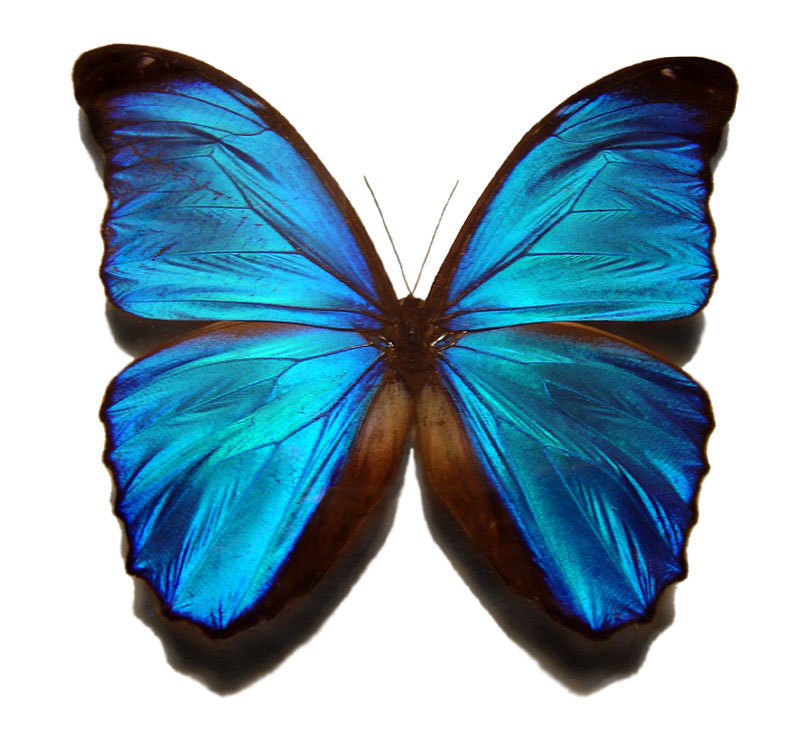- Morpho (butterfly)
Taxobox
name = Morpho Butterfly

image_width = 250px
image_caption = Menelaus Blue Morpho, "Morpho menelaus"
regnum =Animal ia
phylum =Arthropod a
classis =Insect a
ordo =Lepidoptera
unranked_familia =Rhopalocera
superfamilia =Papilionoidea
familia = Nymphalidae
subfamilia =Morphinae
tribus =Morphini
genus = "Morpho"
genus_authority =Fabricius , 1807
type_species = "Papilio achilles"
type_species_authority =Linnaeus , 1758
diversity = c.80 species
diversity_link = Morpho
subdivision_ranks = Species
subdivision = "M. absoloni" "M. achilleana "M. achilles" "M. adonis "M. aega" "M. amathonte" "M. amphitrion" "M. anaxibia" "M. aurora" "M. catenarius" "M. cisseis" "M. cypris" "M. deidamia" "M. diana" "M. didius" "M. godarti" "M. granadensis" "M. hecuba", Sunset Morpho "M. helena"
"M.helenor"
"M. hercules" "M. hycainthus" "M. laertes" "M. leontius" "M. luna" "M. lympharis" "M. menelaus" Menelaus Blue Morpho "M. montezuma" "M. nestira" "M. ockendeni" "M. patroclus" "M. peleides", Peleides Blue Morpho "M. phanodemus" "M. polyphemus", White Morpho "M. portis" "M. rhetenor" "M. rhodopteron" "M. richardus" "M. sulkowskyi" "M. telemachus" "M. thamyris" "M. theseus" "M. vitrea" …A Morpho butterfly may be one of over 80 species of thegenus "Morpho". They areneotropic al butterflies found mostly inSouth America as well asMexico andCentral America [Eugène Le Moult withP.Real "Les Morpho d'Amerique du Sud et Centrale". E. Le Moult, Paris : Editions scientifiques du Cabinet entomologique E. Le Moult. 1962-1963.] . Morphos range in wingspan from the 7.5 cm (3 inch) "M. rhodopteron" to the imposing 20 cm (8 inch)Sunset Morpho , "M. hecuba". The name Morpho, meaning changed or modified, is also anepithet ofAphrodite and Venus.Coloration
Many Morpho butterflies are colored in metallic, shimmering shades of blue and green. These colors are not a result of pigmentation but are an example of
iridescence : the extremely fine lamellated scales covering the Morpho's wings reflect incident light repeatedly at successive layers, leading tointerference effects that depend on both wavelength and angle of incidence/observance [P. Vukusic, J.R. Sambles, C.r. Lawrence, and R.J. Wootton Quantified interference and diffraction in single Morpho butterfly scales Proc. Roy. Soc. Lond. B 266: 1403-11. (1999) http://newton.ex.ac.uk/research/emag/butterflies/pdf/Vukusic_Morpho.pdf] . Thus the colors produced vary with viewing angle, however they are actually surprisingly uniform, perhaps due to the tetrahedral (diamond-like) structural arrangement of the scales or diffraction from overlying cell layers. This structure may be likened to aphotonic crystal . The lamellate structure of their wing scales has been studied as a model in the development of fabrics, dye-free paints, and anti-counterfeit technology used in currency.The iridescent lamellae are only present on the dorsal side of their wings, leaving the ventral side brown.
The ventral side is decorated with "
ocelli " or eyespots. In some species, such as "M. godarti", the dorsal lamellae are so thin as to allow the ventral ocelli to peek through. While not all Morphos have iridescent coloration, they all have ocelli. In most species only the males are colorful, supporting the theory that the coloration is used for intrasexual communication between males. The lamellae reflect up to 70% of light falling on them, including anyUV . The eyes of Morpho butterflies are thought to be highly sensitive to UV light and therefore the males are able to see each other from great distances. Some South American species are reportedly visible by the human eye up to one kilometre away.There also exist a number of white "Morpho" species, principal among these being "M. catenarius" and "M. laertes". An unusual species that is fundamentally white in coloration, but which exhibits a stunning purple iridescence when viewed at certain angles is the rare "M. sulkowskyi", while among the metallic blue "Morpho" species, "M. rhetenor" stands out as the most iridescence of all, with "M. cypris" a close second. Indeed, "M. cypris" is notable in that specimens that are mounted in entomological collections will exhibit color differences across the wings if they are not 'set' perfectly flat.
Habitat
Morpho butterflies are forest dwellers but will venture into sunny clearings to warm themselves. Males are territorial and will chase any rivals. The peoples along the Rio Negro in
Brazil once exploited the territorial habits of theBlue Morpho ("M. menelaus") by luring them into clearings with bright blue decoys. The collected butterfly wings were used as embellishment for ceremonial masks."Morpho" butterflies feed on the juices of fermenting fruit with which they may also be lured. The butterflies wobble in flight and are easy to catch.
The entire life cycle of the Morpho butterfly, from egg to death, is approximately 137 days. The adults live for about a month. They have few predators as the adults are poisonous due to the feeding caterpillar
sequestering poisonous compounds. The hairy browncaterpillar s feed on a variety of leguminous plants. The tufts of hair decorating the caterpillars have been recorded to irritate human skin.The commoner (Blue) Morphos are reared "en masse" in commercial breeding programmes. The iridescent wings are used in the manufacture of
jewellery and as inlay inwoodworking . Papered specimens are sold with the abdomen removed to prevent its oily contents from staining the wings. Significant quantities of live specimens are exported as pupae from several neotropical countries for exhibition in butterfly houses. Unfortunately, due to theirirregular flight pattern and size, their wings are frequently damaged when in captivity.Photographs
Images of various varieties of blue morpho butterflies.
References
External links
* [http://www.funet.fi/pub/sci/bio/life/insecta/lepidoptera/ditrysia/papilionoidea/nymphalidae/morphinae/morpho/index.html Morpho at funet.fi]
* [http://en.butterflycorner.net/Genus-MORPHO.349.0.html Butterflycorner.net]
* [http://www.tolweb.org/Morpho/70770 Tree of Life]
* [http://www.amazoninsect.com Collecting trips to Amazonia]
* [http://www.insectia.com/beta/e/iv_c202047.html Insectia.com: Morpho butterfly profile]
* [http://newton.ex.ac.uk/research/thinfilms/butterflies/morpho_paper.htm Quantified interference and diffraction in single Morpho butterfly scales]
* [http://www.szgdocent.org/ff/f-lep5.htm Singapore Zoological Gardens' butterflies at the Zoo]
* [http://www.open2.net/bluesky/butterfly.htm BBC Blue Sky: flights of fancy]
* [http://stembol.com/morphidae/index.htm Stembol.com: Morpho butterflies]
* [http://www.goliathus.cz/en/museum-morphidae-10.html Morphidae] in [http://www.goliathus.cz/en/museum-homepage-0.html online museum] - including rare gynandomorph of Morphidae
* [http://www.pteron-world.com/topics/classfication/satyridae/morphinae2.html Pteron Page 1] [http://www.pteron-world.com/topics/classfication/satyridae/morphinae3.html#morpho Pteron Page 2] In Japanese butbinomial names against the excellent photos.
* [http://www.flickr.com/search/groups/?w=17748293@N00&q=morpho&m=pool Flickr] Images
Wikimedia Foundation. 2010.
